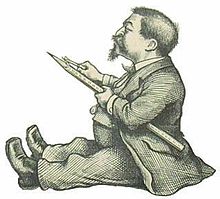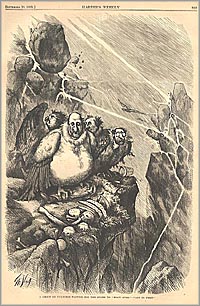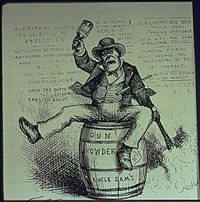User:HarryHenryGebel/Sandbox
Thomas Nast | |
|---|---|
 Self-portrait of Thomas Nast | |
| Born | September 27, 1840 |
| Died | December 7, 1902 (aged 62) |
| Signature | |
 | |
Thomas Nast (September 27, 1840 – December 7, 1902) was a German-born American caricaturist and editorial cartoonist who is considered to be the "Father of the American Cartoon."[1]
Youth and education
[edit]
He was born in the barracks of Landau, Germany (in the Rhine Palatinate), the son of a trombonist in the 9th regiment Bavarian band. The elder Nast's socialist political convictions put him at odds with the German government, and in 1846 he left Landau, enlisting first on a French man-of-war and subsequently on an American ship.[2] He sent his wife and children to New York City, and at the end of his enlistment in 1849 he joined them there. Thomas Nast's passion for drawing was apparent from an early age, and he was enrolled for about a year of study with Alfred Fredericks and Theodore Kaufmann and at the school of the National Academy of Design. After school (at the age of 15), he started working in 1855 as a draftsman for Frank Leslie's Illustrated Newspaper; three years afterward, for Harper's Weekly.
Career
[edit]Nast drew for Harper's Weekly from 1859 to 1860 and from 1862 until 1886. In February 1860, he went to England for the New York Illustrated News to depict one of the major sporting events of the era, the prize fight between the American John C. Heenan and the English Thomas Sayers[3] sponsored by George Wilkes, publisher of Wilkes' Spirit of the Times. A few months later, as artist for The Illustrated London News he joined Garibaldi in Italy. Nast's cartoons and articles about the Garibaldi military campaign to unify Italy captured the popular imagination in the U.S. In 1861, he married Sarah Edwards, whom he had met two years earlier.
One of his first serious works in caricature was the cartoon "Peace," (made in 1862) directed against those in the North who opposed the prosecution of the American Civil War. This and his other cartoons during the Civil War and Reconstruction days were published in Harper's Weekly. He was known for drawing battlefields in border and southern states. These attracted great attention, and Nast was called by President Abraham Lincoln "our best recruiting sergeant".[4] Later, Nast strongly opposed President Andrew Johnson and his Reconstruction policy.
Campaign against the Tweed Ring
[edit]
Boss Tweed depicted by Thomas Nast in a wood engraving published in Harper's Weekly, October 21, 1871

The Tweed Ring depicted by Nast in a wood engraving published in Harper's Weekly, September 23, 1871
Nast's drawings were instrumental in the downfall of Boss Tweed, the powerful Tammany Hall leader. As commissioner of public works for New York City, Tweed led a ring that by 1870 had gained total control of the city's government, and controlled "a working majority in the State Legislature."[5] Tweed and his associates—Peter Barr Sweeny (park commissioner), Richard B. Connolly (controller of public expenditures), and Mayor A. Oakey Hall—defrauded the city of many millions of dollars by grossly inflating expenses paid to contractors connected to the Ring. Nast, whose cartoons attacking Tammany corruption had appeared occasionally since 1867, intensified his focus on the four principal players in 1870 and especially in 1871.
Tweed so feared Nast's campaign that an emissary was sent to offer Thomas Nast a large bribe, which was represented as a gift from a group of wealthy benefactors to enable Nast to study art in Europe.[6] Feigning interest, Nast bid the initial offer of $100,000 up to $500,000 before declaring, "I don't think I'll do it."[7] Nast pressed his attack, and an indignant public rose against the Ring, which was removed from power in the election of November 7, 1871. Tweed was arrested in 1873 and convicted of fraud. When Tweed attempted to escape justice in December 1875 by fleeing to Cuba and from there to Spain, officials in Vigo, Spain were able to identify the fugitive by using one of Nast's cartoons.[8]
Nast, a German Protestant, saw the Catholic Church as a threat to American values, and often portrayed the Irish Catholics and Catholic Church leaders in very hostile terms. In 1871, one of his works, titled "The American River Ganges," infamously portrayed Catholic bishops as crocodiles waiting to attack American school children. Nast's anti-Irish sentiment is clearly apparent in his characteristic depiction of the Irish as violent drunks.


In general, his political cartoons supported American Indians, Chinese Americans and advocated abolition of slavery. Nast also opposed segregation and the violence of the Ku Klux Klan, which was depicted in one of his more famous cartoons called "Worse than Slavery," which showed a despondent black family having their house destroyed by arson, as two members of the Ku Klux Klan and White League shake hands in their mutually destructive work against black Americans. His cartoons frequently had numerous sidebars and panels with intricate subplots to the main cartoon. A Sunday feature could provide hours of entertainment and highlight social causes. His signature "Tammany Tiger" has been emulated by many cartoonists over the years, and he introduced into American cartoons the practice of modernizing scenes from Shakespeare for a political purpose.

Party politics
[edit]Harper's Weekly, and Nast, played an important role in the election of Ulysses Grant in 1868 and 1872; in the latter campaign, Nast's ridicule of Horace Greeley's candidacy was especially merciless. Nast became a close friend of President Grant and the two families shared regular dinners until Grant's death. Nast encouraged the former president's efforts in writing his autobiography while battling cancer.
He moved to Morristown, New Jersey in 1872 and lived there for many years. In 1873, Nast toured the United States as a lecturer and a sketch-artist, as he would do again in 1885 and 1887.
He shared political views with his friend Mark Twain and was for many years a staunch Republican. Nast opposed inflation of the currency, notably with his famous rag-baby cartoons, and he played an important part in securing Rutherford B. Hayes’ presidential election in 1876. Hayes later remarked that Nast was "the most powerful, single-handed aid [he] had",[9] but Nast quickly became disillusioned with President Hayes, whose policy of Southern pacification he opposed. He was not given free rein to attack Hayes in Harper's, however; with the death of Fletcher Harper in 1877, Nast lost an important champion at the journal, and his contributions became less frequent. He focused on oil paintings and book illustrations, but these are comparatively unimportant.[citation needed]

In 1884, his advocacy of civil service reform and his distrust of James G. Blaine, the Republican presidential candidate, forced him to become a Mugwump, whose support of Grover Cleveland helped him to win election as the first Democratic president since 1856. In the words of the artist's grandson, Thomas Nast St Hill, "it was generally conceded that Nast's support won Cleveland the small margin by which he was elected. In this his last national political campaign, Nast had, in fact, 'made a president.'"[10] Nevertheless, Nast's tenure at Harper's Weekly ended with his Christmas illustration of December 1886. In the words of journalist Henry Watterson, "in quitting Harper's Weekly, Nast lost his forum: in losing him, Harper's Weekly lost its political importance."[11]
In 1890, he published Thomas Nast's Christmas Drawings for the Human Race. He contributed cartoons in various publications, notably the Illustrated American, but with the advent of new methods and younger blood his vogue was passed. In 1892, he took control of a failing magazine, the New York Gazette, and renamed it Nast's Weekly. Now returned to the Republican fold, Nast used the Weekly as a vehicle for his cartoons supporting Benjamin Harrison for president, but the magazine had little impact and ceased publication shortly after Harrison's defeat.[12]
In 1902 Theodore Roosevelt appointed him as the United States' Consul General to Guayaquil, Ecuador in South America. During a deadly yellow fever outbreak, Nast stayed to the end helping numerous diplomatic missions and businesses escape the contagion. At age 62, in 1902, he died of yellow fever contracted there. His body was returned to the United States where he was interred in the Woodlawn Cemetery in The Bronx, New York.
Notable works
[edit]
Nast's depiction of iconic characters, such as Santa Claus and Uncle Sam, are widely credited with giving us the recognized versions we see today.
- A classic version of Santa Claus, drawn in 1863 for Harper's Weekly. Before then, most depictions of Santa Claus showed a tall, thin man. Nast drew him as the bearded, plump man known today.
- Republican Party elephant[13]
- Democratic Party donkey
- Tammany Hall tiger, a symbol of Boss Tweed's political machine
- Columbia, a graceful image of the Americas as a woman, usually in flowing gown and tiara, carrying a sword to defend the downtrodden.
- Uncle Sam, a lanky image of the United States (first drawn in the 1830s; Nast and John Tenniel added the goatee).
- John Confucius, a variation of John Chinaman, a traditional caricature of a Chinese Immigrant.
- The Fight at Dame Europa's School, 1871
Supposed origins of the word "Nasty"
[edit]There is a misconception among some that the word "nasty" originated from Thomas Nast's name, due to the tone of his cartoons.[14] However, the word "nasty" has origins hundreds of years before Thomas Nast was born.[15]
Notes
[edit]- ^ "The Historic Elephant and Donkey; It Was Thomas Nast "Father of the American Cartoon," Who Brought Them Into Politics" (PDF). New York Times. 08/02/1908. p. SM9. Retrieved 2008-07-12.
{{cite news}}: Check date values in:|date=(help) - ^ Paine 1974, p. 7.
- ^ Paine 1974, p. 36.
- ^ Paine 1974, p.69.
- ^ Paine 1974, p. 140.
- ^ Paine 1974, p. 181.
- ^ Paine 1974, pp. 181–182.
- ^ Paine 1974, pp. 336–337.
- ^ Paine 1974, p. 349.
- ^ Nast & St. Hill 1974, p. 33.
- ^ Paine 1974, p. 528.
- ^ Paine 1974, p. 540.
- ^ Jennifer J. Rodibaugh "Cartoonery," American Heritage, Spring/Summer 2008.
- ^ About.com
- ^ Harper, Douglas (November 2001). "nasty etymology". Online Etymology Dictionary. Retrieved 2009-02-01.
References
[edit]
- Nast, T., & St. Hill, T. N. (1974). Thomas Nast: Cartoons and Illustrations. New York: Dover Publications. ISBN 0-486-23067-8
- Paine Albert Bigelow (1904). Th. Nast: His Period And His Pictures. New York: The MacMillan Company.
{{cite book}}:|access-date=requires|url=(help); Cite has empty unknown parameter:|coauthors=(help); External link in|title= - Chisholm, Hugh, ed. (1911). Encyclopædia Britannica (11th ed.). Cambridge University Press.
{{cite encyclopedia}}: Missing or empty|title=(help)
External links
[edit]- Elections 1860-1912 as covered by Harper's Weekly; news, editorials, cartoons (many by Nast)
- still more Nast
- ThomasNast.com
- Thomas Nast Civil War Pictures
- Thomas Nast Caricatures of the Civil War, Reconstruction, Santa Claus, Napoleon, Catholicism, Boss Tweed, Tammany Hall and more.
- Cartoons of Thomas Nast: Reconstruction, Chinese Immigration, Native Americans, Gilded Era
- . Appletons' Cyclopædia of American Biography. 1900.
 Beach, Chandler B., ed. (1914). The New Student's Reference Work. Chicago: F. E. Compton and Co.
Beach, Chandler B., ed. (1914). The New Student's Reference Work. Chicago: F. E. Compton and Co. {{cite encyclopedia}}: Missing or empty|title=(help)- Thomas Nast at Find a Grave
Category:American caricaturists
Category:American editorial cartoonists
Category:American political writers
Category:American satirists
Category:People of the American Civil War
Category:People of New York (state) in the American Civil War
Category:Anti-Catholicism in the United States
Category:German emigrants to the United States
Category:American people of German descent
Category:American artists of German descent
Category:Naturalized citizens of the United States
Category:People from Morristown, New Jersey
Category:Deaths from yellow fever
Category:Infectious disease deaths in Ecuador
Category:1840 births
Category:1902 deaths
